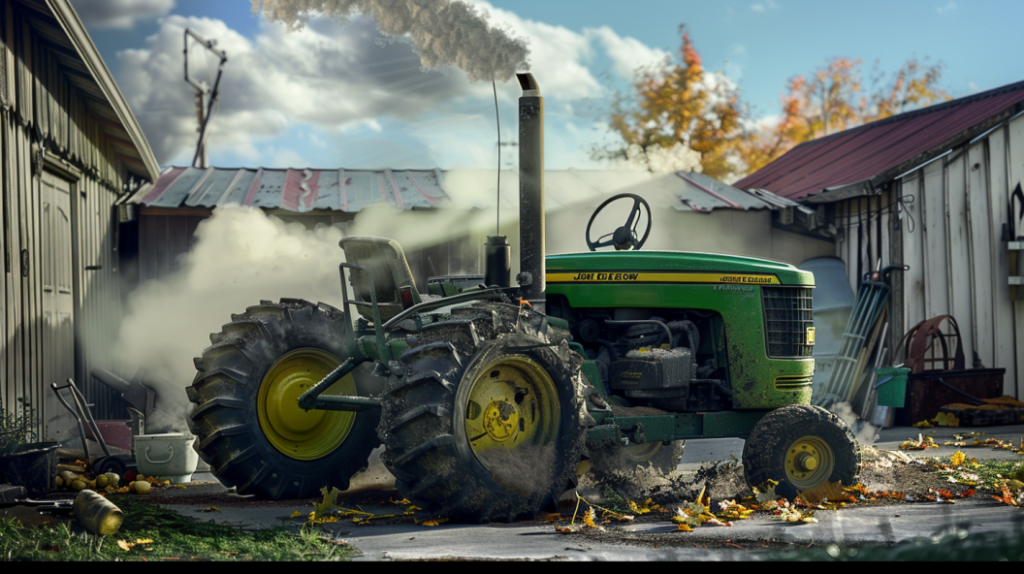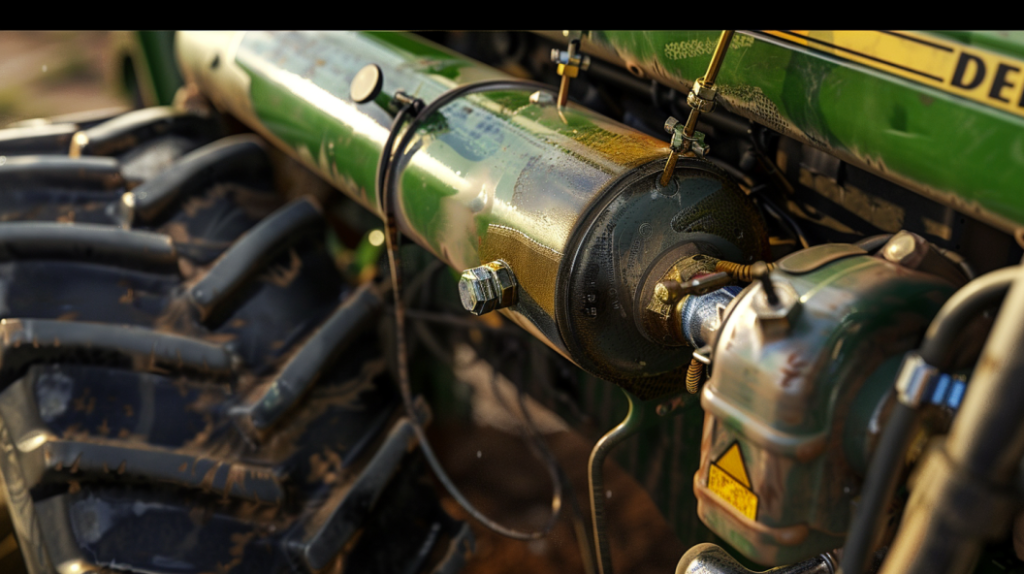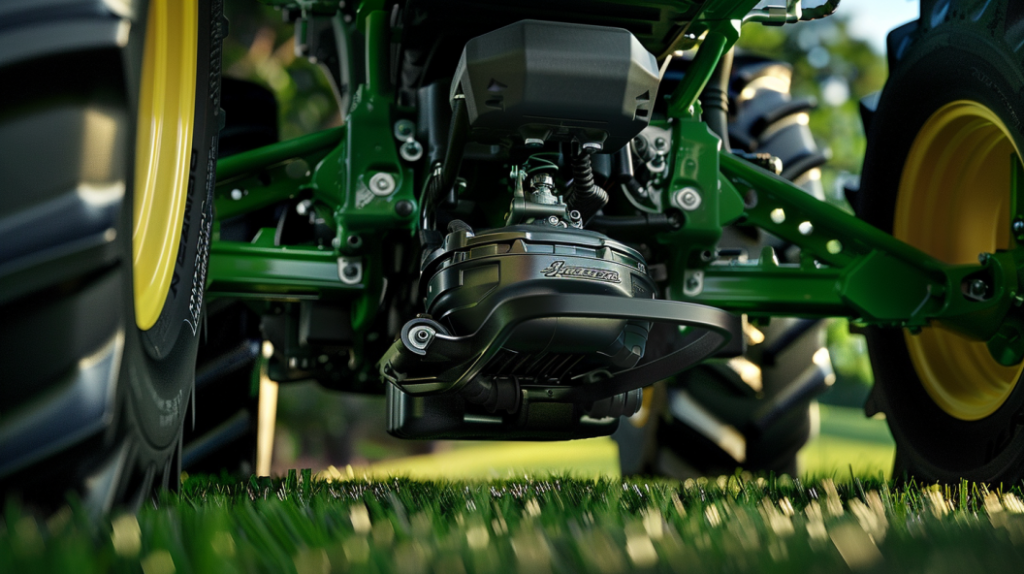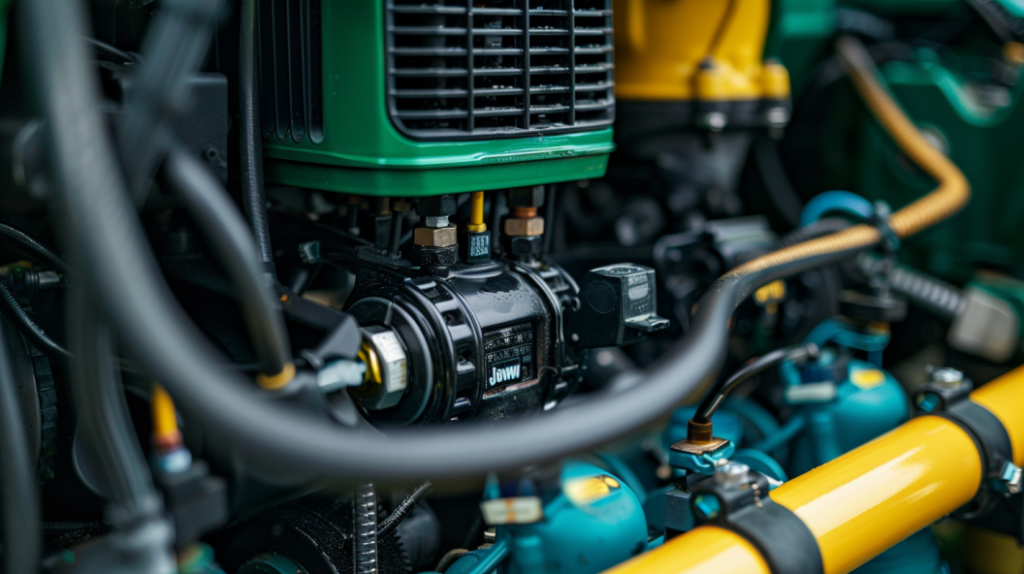If you own a John Deere GT235, you might have encountered some common issues that can hinder its performance. From hydraulic leaks to electrical faults and steering system troubles, these problems can be frustrating. But fear not, there are fixes available to address these concerns and get your GT235 back in top shape. So, before you tackle that next mowing task, make sure you’re equipped with the knowledge to troubleshoot and resolve these common issues efficiently. Your GT235 will thank you for it.
Key Takeaways
- Hydraulic leaks from fittings and hoses can be resolved by tightening fittings and replacing damaged hoses promptly.
- Transmission issues like lack of responsiveness or strange noises may indicate low fluid levels or internal damage.
- Electrical faults such as battery issues or wiring damage require thorough inspection and testing for proper operation.
- Engine troubleshooting involves checking oil, air filter, spark plug, and fuel filter regularly to prevent performance issues.
- Steering system maintenance includes checking for wear, proper alignment, and leaks to ensure smooth operation.
Hydraulic Leaks

Hydraulic leaks in the John Deere GT235 typically occur around the fittings and hoses due to wear and tear over time. These leaks can lead to a loss of hydraulic fluid, causing a decrease in the efficiency of the machine.
To address this issue, start by conducting a visual inspection of the fittings and hoses to identify the source of the leak. Look for signs of wear such as cracks, corrosion, or loose connections. Tighten any loose fittings and replace damaged hoses to prevent further leakage.
Make sure that all fittings are securely tightened to the manufacturer’s specifications using the appropriate tools. When replacing hoses, use high-quality hydraulic hoses that are compatible with the John Deere GT235 to ensure a proper fit and seal.
Regularly inspect the hydraulic system for any signs of leaks and address them promptly to maintain the peak performance of your machine. By taking these preventive measures, you can avoid costly repairs and downtime due to hydraulic leaks.
Transmission Issues
Inspecting the transmission system in your John Deere GT235 is crucial to identifying and resolving potential issues that may affect the performance of your machine. One common problem is a lack of responsiveness in gear shifting. This could be due to low transmission fluid levels, which should be checked and topped up if needed.
Another issue could be strange noises during operation, indicating potential internal damage, requiring a professional inspection.
If you notice the transmission slipping, where the machine struggles to accelerate, this could be a sign of worn-out transmission components. In such cases, parts like the drive belt or pulleys might need replacing.
Additionally, if you experience jerky movements or sudden stops while driving, it could point to a faulty transmission control module that needs to be diagnosed and repaired.
Regular maintenance, such as changing the transmission fluid and inspecting components for wear, can prevent these issues. Being proactive in monitoring your John Deere GT235’s transmission system will ensure smooth operation and prevent costly repairs down the line.
Electrical Faults
How can you troubleshoot electrical faults in your John Deere GT235 efficiently? Electrical issues in your John Deere GT235 can be frustrating, but with a systematic approach, you can diagnose and fix them effectively.
Start by checking the battery to make sure it’s properly connected and charged. Inspect the battery terminals for any corrosion and clean them if needed.
Next, examine the wiring harness for any signs of damage or wear. Make sure all connections are secure and free of debris.
Test the fuses using a multimeter to determine if any have blown. Replace any faulty fuses with ones of the correct rating.
Additionally, check the ignition switch and starter solenoid for proper functioning. If these components are faulty, they may need to be repaired or replaced.
Engine Problems

To address engine problems in your John Deere GT235, start by checking the oil level and quality as a first step in troubleshooting. Low oil levels or dirty oil can cause engine performance issues. If the oil is low, top it up with the recommended oil type for your engine. Make sure the oil is clean and free of debris that could clog the engine components.
Next, inspect the air filter for any blockages as a clogged air filter can restrict airflow to the engine, affecting its performance. Replace the air filter if it’s dirty or damaged.
Additionally, check the spark plug to confirm it’s in good condition. A worn-out spark plug can lead to starting difficulties and poor engine operation.
If the engine continues to have problems, it might be necessary to clean or replace the fuel filter to guarantee proper fuel flow. Regular maintenance and following the manufacturer’s guidelines for oil changes and filter replacements can prevent many engine issues in your John Deere GT235.
Steering System Troubles
If you’re experiencing steering system troubles with your John Deere GT235, a common issue to investigate is the condition of the steering linkage and components. Start by checking the steering wheel for any excessive play or stiffness. Examine the tie rods, drag link, and steering gear for signs of wear, damage, or loose connections. Tighten any loose components and replace any worn-out parts to guarantee proper steering functionality.
Next, inspect the steering wheel alignment. Misaligned wheels can cause steering difficulties and uneven tire wear. Adjust the front wheels to the correct alignment specifications recommended in the GT235 manual. Ensure that the tires are inflated to the proper pressure as underinflated tires can also impact steering performance.
If the steering issues persist, it may be necessary to check the power steering system. Inspect the power steering pump, fluid levels, and hoses for any leaks or malfunctions. Properly maintaining the power steering system can help prevent steering problems and ensure smooth operation of your John Deere GT235.
Fuel System Issues

If you’re experiencing issues with your John Deere GT235’s fuel system, two common culprits could be a clogged fuel filter or a malfunctioning fuel pump.
A clogged fuel filter can restrict fuel flow, leading to engine performance issues, while a faulty fuel pump may result in inadequate fuel delivery to the engine.
Addressing these fuel system problems promptly is crucial for maximizing the performance of your John Deere GT235.
Clogged Fuel Filter
A common issue encountered with the John Deere GT235 mower is a restricted fuel flow due to a clogged fuel filter affecting the fuel system’s performance. When faced with a clogged fuel filter, it’s important to address the problem promptly to prevent further damage to your mower.
Here are some key points to keep in mind:
- Symptoms: Look out for signs such as difficulty starting the engine, poor engine performance, or stalling during operation. These could indicate a clogged fuel filter.
- Maintenance: Regularly inspect and replace the fuel filter as part of your mower maintenance routine to ensure peak performance.
- Cleaning vs. Replacement: In some cases, a clogged fuel filter can be cleaned; however, if the filter is severely blocked or damaged, it’s recommended to replace it.
- Preventive Measures: To prevent future clogging issues, consider using high-quality fuel and keeping your fuel system clean and free of debris.
Fuel Pump Malfunction
When dealing with fuel system issues on your John Deere GT235 mower, a common problem to watch out for is a malfunctioning fuel pump, which can greatly impact the engine’s performance. The fuel pump is responsible for delivering fuel from the tank to the engine at the correct pressure. If the fuel pump malfunctions, it can lead to issues such as engine stalling, rough idling, or even failure to start. To diagnose a fuel pump problem, you can perform a fuel pressure test using a pressure gauge to determine if the pump is delivering fuel at the proper pressure levels. If the fuel pump is indeed the issue, it will need to be replaced to guarantee proper engine function.
| Signs of Fuel Pump Malfunction | Possible Causes | Solutions |
|---|---|---|
| Engine Stalling | Clogged Fuel Filter, Faulty Pump | Replace Fuel Pump |
| Rough Idling | Low Fuel Pressure | Test and Replace Fuel Pump |
| Failure to Start | Insufficient Fuel Delivery | Inspect Pump and Replace if Necessary |
Mower Deck Malfunctions
When addressing mower deck malfunctions on your John Deere GT235, key points to keep in mind include adjusting belt tension, replacing blades correctly, and employing effective deck cleaning techniques.
Proper belt tension guarantees top performance and longevity, while blade replacement must adhere to manufacturer guidelines for safety and efficiency.
Regular deck cleaning not only maintains the mower’s appearance but also prevents debris buildup that can hinder cutting performance.
Belt Tension Adjustment
To guarantee proper functioning of your John Deere GT235 mower deck, it’s crucial to regularly adjust the belt tension to prevent malfunctions. Proper belt tension ensures that power is efficiently transferred from the engine to the mower blades, optimizing cutting performance and preventing premature wear on the belts and pulleys.
Here are some key steps to adjust the belt tension on your John Deere GT235:
- Check Belt Condition:
Inspect the mower deck belts for any signs of wear, cracks, or damage that may affect tension adjustment.
- Locate Tension Adjustment Nut:
Identify the tension adjustment nut on the mower deck. It’s usually located near the idler pulley.
- Adjust Tension:
Use the appropriate tool to turn the tension adjustment nut clockwise to increase tension or counterclockwise to decrease tension.
- Verify Tension:
After adjustment, ensure the belt has proper tension by gently pressing on it. There should be a slight deflection but not too loose.
Blade Replacement Tips
Effectively maintaining your John Deere GT235 mower deck includes mastering proper blade replacement techniques to address potential malfunctions. When replacing blades, always begin by disconnecting the spark plug wire to guarantee safety.
Use a block of wood to prevent the blades from rotating while loosening the blade bolt. Remember that the cutting edge of the blade should face away from the deck. Tighten the blade bolt to the manufacturer’s recommended torque specifications to prevent imbalance issues.
Inspect the blades for any signs of damage like bends, nicks, or dullness. Dull blades can tear grass instead of cleanly cutting it, leading to an uneven lawn surface. Regularly sharpen or replace blades as needed to sustain a well-manicured lawn.
Additionally, check for proper blade alignment to prevent excessive vibrations and premature wear on the mower deck components. By following these blade replacement tips, you can keep your John Deere GT235 mower deck operating smoothly and efficiently.
Deck Cleaning Techniques
Proper maintenance of your John Deere GT235 mower deck hinges on implementing effective deck cleaning techniques to address potential malfunctions. To keep your mower deck in top condition, follow these essential cleaning steps:
- Regular Inspection: Check the mower deck regularly for any debris buildup, grass clippings, or rust formation. Addressing these issues promptly can prevent more severe problems in the future.
- Cleaning Under the Deck: Use a scraper or brush to remove grass clippings and dirt from under the deck. This ensures proper airflow and prevents moisture accumulation that can lead to rust.
- Washing the Deck: Periodically wash the deck with water to remove stubborn debris. Avoid using high-pressure washers as they can damage the deck’s components.
- Drying and Lubricating: After cleaning, thoroughly dry the deck to prevent rust. Apply a thin layer of lubricant to moving parts like pulleys and spindles to ensure smooth operation.
Battery Troubleshooting
Inspect the battery connections for any signs of corrosion or loose fittings to troubleshoot potential issues with your John Deere GT235. Corrosion can hinder the flow of electricity from the battery to the mower, leading to starting problems or a lack of power.
Start by disconnecting the battery cables and cleaning the terminals with a mixture of baking soda and water. Use a wire brush to scrub off any corrosion gently. Make sure that the cables are securely attached to the terminals after cleaning.
Next, check the battery’s voltage using a multimeter. A fully charged battery should read around 12.6 volts. Anything noticeably lower may indicate a weak battery that needs replacement. If the battery voltage is low, try jump-starting the mower or using a battery charger to see if it holds a charge.
If these steps don’t solve the issue, consider having the battery load-tested at a local auto parts store to determine its health accurately. Remember to always wear protective gear when handling batteries.
Cooling System Challenges
If your John Deere GT235 is experiencing cooling system challenges, overheating causes and radiator leaks are common culprits to investigate.
Understanding the reasons behind overheating issues can help you pinpoint the root of the problem and take appropriate corrective actions.
Addressing radiator leaks promptly is crucial to guarantee the proper functioning of your GT235’s cooling system.
Overheating Causes
Addressing the issue of overheating in your John Deere GT235 involves a thorough examination of the cooling system challenges. To pinpoint the causes behind the overheating problems, consider the following:
- Low Coolant Levels: Check the coolant reservoir to make sure it’s filled to the recommended level. Low coolant levels can lead to insufficient cooling of the engine.
- Faulty Thermostat: A malfunctioning thermostat can disrupt the normal flow of coolant through the engine, causing overheating issues.
- Clogged Radiator: Inspect the radiator for any blockages that may be restricting the flow of coolant. A clogged radiator can impede the cooling process.
- Damaged Water Pump: The water pump is responsible for circulating coolant through the engine. If the water pump is faulty or damaged, it can result in inadequate cooling and overheating.
Radiator Leaks Fix
To effectively rectify radiator leaks in your John Deere GT235 and overcome cooling system challenges, meticulous examination and precise repairs are crucial. Begin by locating the source of the leak, which could be due to a damaged radiator hose, a corroded radiator, or a faulty radiator cap.
Inspect the radiator hoses for cracks, bulges, or leaks, and replace them if necessary. Check the radiator for any signs of corrosion or physical damage, as these can lead to leaks. Tighten or replace the radiator cap to guarantee it maintains the proper pressure in the system.
Once you have identified the source of the leak, drain the coolant from the system and flush it to remove any debris or contaminants. Use a quality radiator sealant or epoxy specifically designed for radiator repairs to seal the leak effectively.
Allow the sealant to cure according to the manufacturer’s instructions before refilling the radiator with fresh coolant. Finally, pressure test the cooling system to make sure the leak has been successfully repaired and that your John Deere GT235 is running smoothly once again.

Tire and Wheel Problems
Experiencing frequent tire punctures and uneven wear on the wheels is a common issue reported by John Deere GT235 owners. This can lead to reduced traction, steering difficulties, and an overall compromised riding experience.
To address these tire and wheel problems effectively, consider the following:
- Check Tire Pressure Regularly: Maintaining the correct tire pressure is vital to prevent punctures and uneven wear. Use a pressure gauge to make sure the tires are inflated to the recommended levels.
- Inspect for Debris: Thoroughly examine the tires and wheels for any embedded objects like nails or sharp stones that could cause punctures. Remove any debris carefully to prevent future issues.
- Rotate Tires: Uneven wear can be minimized by regularly rotating the tires. This ensures that the tires wear down more evenly, extending their lifespan.
- Consider Upgrading Tires: If tire punctures are a persistent problem, upgrading to puncture-resistant tires may provide a more durable solution for your John Deere GT235.
Frequently Asked Questions
How Often Should I Change the Hydraulic Fluid in My John Deere Gt235?
You should change the hydraulic fluid in your John Deere GT235 as per the manufacturer’s recommendation, typically every 200-250 hours of use or annually. Regular maintenance guarantees peak performance and longevity of your equipment.
Neglecting this essential task can lead to decreased efficiency, increased wear and tear on components, and potential costly repairs down the line. Stay proactive and keep your GT235 running smoothly by adhering to the recommended maintenance schedule.
Can I Use a Universal Transmission Fluid in My John Deere Gt235?
You may be tempted to use universal transmission fluid in your John Deere GT235, but it’s not recommended. Using the manufacturer’s recommended transmission fluid guarantees peak performance and longevity for your machine.
Different fluids have varying viscosities and additives that may not be suitable for your specific equipment. To prevent potential damage and ensure smooth operation, stick to the fluid specified in the manual.
What Could Cause My John Deere GT235 to Experience Electrical Shorts?
To cause electrical shorts in your John Deere GT235, potential culprits may include worn or damaged wiring, loose connections, faulty switches, or a malfunctioning voltage regulator.
Inspect the electrical system thoroughly, checking for any exposed wires, frayed insulation, or corroded terminals.
Tighten all connections and replace any damaged components. Regular maintenance and ensuring proper wiring integrity can help prevent electrical issues in your machine.
How Can I Prevent Overheating in My John Deere GT235 Engine?
To prevent overheating in your John Deere GT235 engine, maintain proper airflow by keeping the cooling fins clean and unobstructed.
Regularly check and clean the engine’s cooling system, including the radiator and coolant levels.
Monitor the engine temperature gauge while operating the mower to catch any early signs of overheating.
Additionally, avoid overworking the engine in extreme temperatures and maintain a consistent maintenance schedule to keep the engine running smoothly.
Are Aftermarket Steering Components Compatible With the John Deere Gt235?
Aftermarket steering components may not always be compatible with the John Deere GT235 due to variations in design and specifications. It’s important to confirm that any replacement parts meet the necessary standards and dimensions to fit and function properly.
Using non-compatible components can lead to steering issues, compromising the safety and performance of your equipment. Always verify compatibility before installing aftermarket parts on your John Deere GT235.
Conclusion
To sum up, addressing hydraulic leaks, transmission issues, electrical faults, engine problems, steering system troubles, mower deck malfunctions, battery troubleshooting, cooling system challenges, and tire and wheel problems on your John Deere GT235 is crucial for peak performance.
By regularly maintaining and inspecting these components with attention to detail, you can guarantee the smooth operation of your equipment and extend its lifespan.
Keep up with maintenance to keep your GT235 running like a well-oiled machine.
Leave a Reply